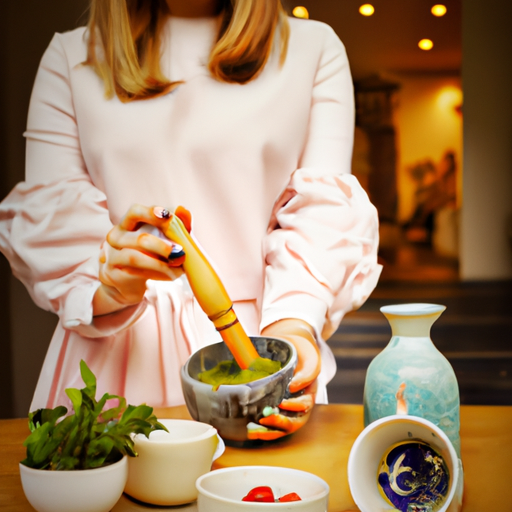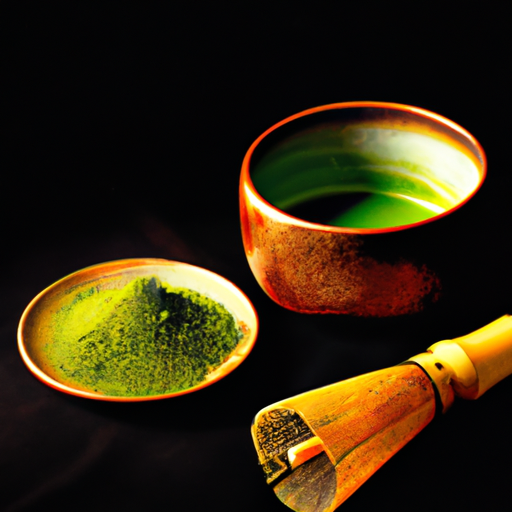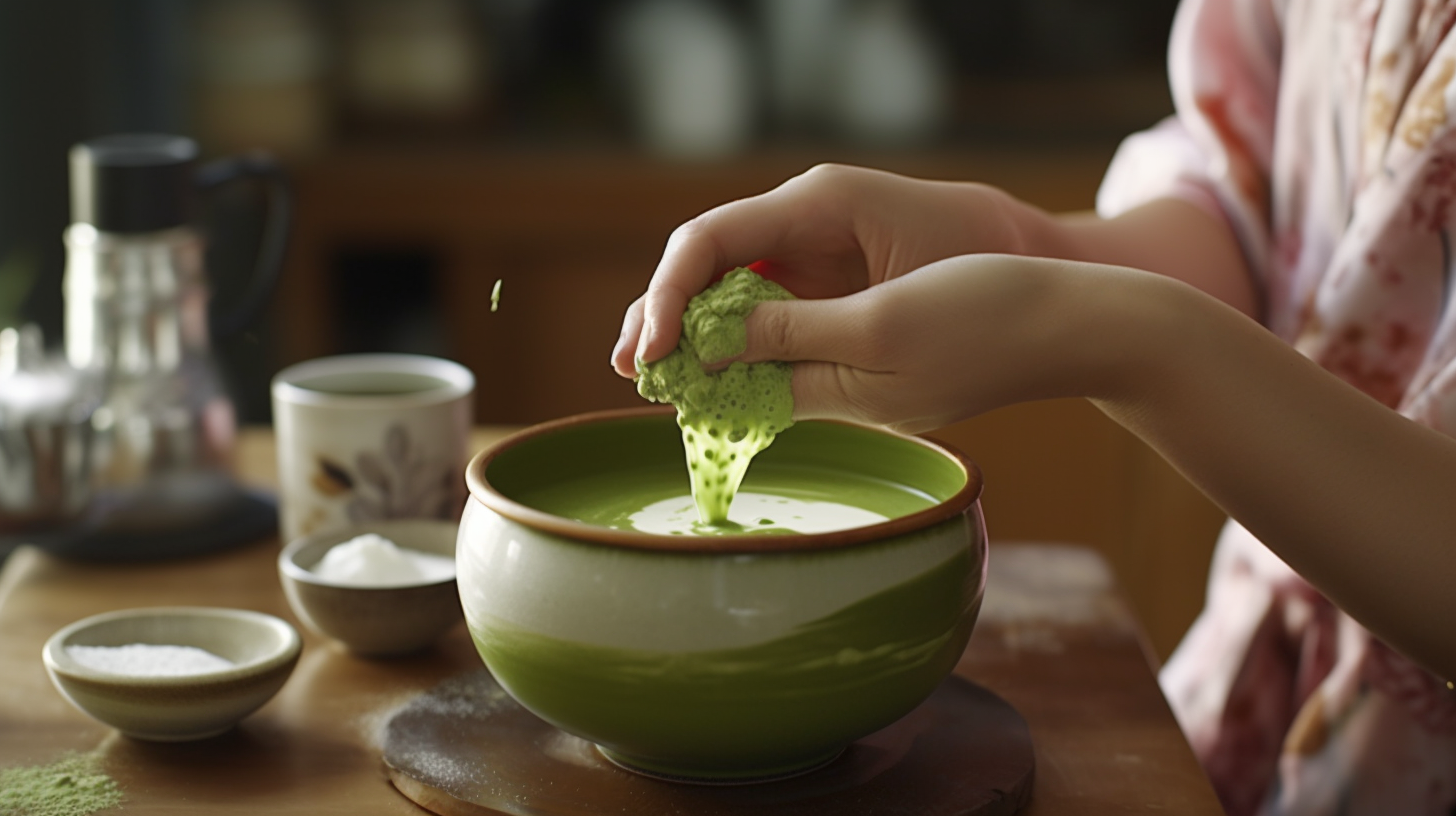I’ve always enjoyed green tea, but my introduction to matcha left me amazed by its distinct taste and the health advantages it offers. Matcha is a form of green tea which is finely ground into powder form, often utilized in traditional Japanese tea ceremonies.
But you don’t have to attend a ceremony to enjoy the benefits of matcha – you can make your own powder at home with just a few simple steps. To start, you’ll need high-quality green tea leaves. Look for leaves that are bright green and have a fresh, grassy aroma.
Once you have your leaves, it’s time to prepare them for grinding. In this article, I’ll guide you through the process of making matcha powder from green tea and share some tips for making the perfect cup of matcha. So grab your tea leaves and let’s get started!
Key Takeaways
- High-quality green tea leaves are essential to making delicious matcha powder.
- Proper storage techniques are crucial in maintaining the quality and freshness of matcha powder.
- Matcha powder is packed with antioxidants and has various health benefits.
- Making your own matcha powder allows you to control the quality and customize the texture and intensity to your liking.
Choose High-Quality Green Tea Leaves
To make delicious matcha powder, it’s crucial to choose high-quality green tea leaves that will provide an excellent flavor and aroma. When selecting leaves, look for bright and vibrant green tea leaves that have been grown in the shade. These tea leaves are typically the youngest and most tender leaves, which results in a smoother and sweeter matcha flavor.
Once you’ve chosen the best leaves, it’s time to prepare them for grinding. The leaves need to be steamed and dried before they can be ground into matcha powder. This process helps to stop the oxidation process in the leaves and preserves their bright green color.
After steaming and drying, the leaves are ready to be ground into a fine powder, which can be used to make delicious matcha drinks and desserts.
Prepare the Green Tea Leaves
Firstly, when it comes to making matcha powder from green tea, preparation techniques are crucial. Once you’ve selected high-quality leaves, it’s time to prepare them for grinding into powder.
The first step in this process is to gently steam the leaves to prevent oxidation and preserve their vibrant green color. This process also helps to soften the leaves, making them easier to grind.
Once the leaves have been steamed, they are then dried and sorted to remove any impurities. This ensures that only the highest quality leaves are used in the final product.
Proper tea leaf selection and preparation are essential to producing matcha powder with optimal flavor and texture. With the leaves now prepared, it’s time to move on to the next step: grinding them into a fine powder.
Grind the Leaves into Powder
Now that you’ve prepared the high-quality leaves, it’s time to grind them into a fine powder, ensuring that only the best leaves are used in the final product. Grinding the leaves into powder is what gives matcha its unique flavor and texture.
There are different grinding techniques to achieve the desired consistency, but the most traditional one is using a stone mill. When grinding the leaves, it’s important to consider the matcha flavor profiles you want to achieve.
A longer grinding time and slower rotation speed results in a smoother and sweeter flavor, while a shorter grinding time and faster rotation speed results in a more bitter and astringent flavor. It’s also important to keep the leaves cool during the grinding process to prevent heat from altering the flavor.
Once the leaves are ground into a fine powder, sift it to remove any clumps and ensure a smooth texture. Now that the matcha powder is ready, it’s important to store it properly to maintain its freshness and flavor.
Store the Matcha Powder
Now that I’ve ground my green tea leaves into matcha powder, it’s important to store it properly to maintain its freshness and flavor. Choosing the right container is crucial.
I prefer an airtight container made of tin or ceramic, which helps to protect the matcha from moisture and light. Additionally, storing the container in a cool, dry place, away from direct sunlight, will help ensure that the matcha powder stays fresh for longer.
Choosing the Right Container
When picking a container for your matcha powder, it’s important to consider its size and material. The container should be big enough to hold the amount of matcha powder you plan to store, yet small enough to fit in your pantry or cupboard.
Glass and tin containers are great options since they don’t absorb odor or moisture, which can affect the quality of your matcha powder. Avoid plastic containers since they can leave a plastic-like taste on your matcha powder.
Aside from the size and material, you should also look for a container that has an airtight seal. This will prevent air from entering the container, which can cause the matcha powder to oxidize and lose its quality.
Once you have chosen the right container, make sure to label it with the date of purchase so you can keep track of its shelf life. Proper storage techniques are crucial in maintaining the quality and freshness of your matcha powder, so storing in a cool, dry place is the next important step.
Storing in a Cool, Dry Place
To keep your prized powdered drink pristine, place the container in a cool and dry corner of your pantry or cupboard. Proper storage is essential in maintaining the quality of your matcha powder. Exposure to humidity and high temperatures can significantly shorten its shelf life and affect its taste and aroma.
The effects of humidity and temperature on matcha powder are significant. High humidity can cause clumping, while heat can cause the powder to lose its vibrant green color and delicate flavor. To prevent these issues, make sure to store your matcha powder in an airtight container in a cool, dry place. This will help maintain its freshness and quality for longer. With proper storage, you can enjoy a delicious cup of matcha anytime you want.
Transition: Now that you know how to store your matcha powder properly, it’s time to move on to some tips for making the perfect cup of matcha.
Tips for Making the Perfect Cup of Matcha
For the perfect cup of matcha, you’ll want to make sure your water is not boiling hot, as it can scorch the matcha powder and make it bitter. Instead, heat your water to about 175 degrees Fahrenheit and then pour it over your matcha powder. This will allow the powder to release its flavor and aroma, resulting in a smooth and delicious cup of matcha.
Matcha brewing techniques can also vary depending on personal preference. Some people like to whisk their matcha powder in a bowl with a bamboo whisk, while others prefer to blend it in a blender or shake it in a shaker bottle.
Similarly, matcha flavor variations can also be achieved by using different types of green tea leaves to make the powder. Experimenting with different brewing techniques and flavors can help you find the perfect cup of matcha that suits your taste.
Moving forward, using matcha powder in recipes is a great way to incorporate its unique flavor and health benefits into your cooking and baking.
Using Matcha Powder in Recipes
Now that we’ve covered some tips for making the perfect cup of matcha, let’s dive into using matcha powder in recipes. Matcha powder is a versatile ingredient that can be used in a variety of recipes, from desserts to savory dishes. One of my favorite ways to use matcha powder is in a smoothie bowl.
I mix a teaspoon of matcha powder with frozen bananas, almond milk, and a scoop of vanilla protein powder for a delicious and energizing breakfast. But matcha powder isn’t just delicious, it also has numerous health benefits. Matcha powder is packed with antioxidants, which can help protect against cancer and heart disease.
It also contains L-theanine, an amino acid that promotes relaxation and reduces stress. Plus, matcha powder has been shown to boost metabolism and improve brain function. Incorporating matcha powder into your diet can be a great way to improve your overall health and wellbeing. As you can see, matcha powder is a powerful ingredient that can enhance both the flavor and nutritional value of your recipes.
But did you know that you can even make your own matcha powder from green tea leaves? By making your own matcha powder, you can ensure that it is fresh and free of any additives or preservatives. So, let’s explore the benefits of making your own matcha powder.
Benefits of Making Your Own Matcha Powder
You can harness the full potential of fresh, additive-free matcha by creating your own powder from whole green tea leaves. Not only will you be able to customize the texture and intensity of your matcha, but you’ll also be able to reap the benefits of the DIY matcha process.
Here are three reasons why you should consider making your own matcha powder:
-
You can ensure that your matcha is free of additives and pesticides. By starting with high-quality green tea leaves, you’re able to control the quality of your matcha and avoid any harmful chemicals that may be present in pre-packaged matcha powders.
-
You’ll be able to adjust the texture and intensity of your matcha powder to your liking. Depending on the desired use, you can grind your green tea leaves into a fine or coarse powder, giving you the ability to tailor your matcha to your specific needs.
-
Making your own matcha powder can be a fun and rewarding experience. Not only will you have a sense of accomplishment in creating your own matcha, but you’ll also have a deeper appreciation for the process and the tea itself.
When it comes to making your own matcha powder, there are some common mistakes to avoid.
Common Mistakes to Avoid
Avoid ruining your homemade matcha powder by sidestepping these common errors and experiencing the full benefits of your labor. One of the most common mistakes people make when making matcha powder is clumping. Clumping occurs when the tea leaves are not ground finely enough or if there is too much moisture when grinding. To avoid this, make sure your tea leaves are completely dry before grinding and use a high-quality grinder that can produce a fine powder.
Another mistake to avoid is not getting the right consistency. Matcha powder should be fine and smooth, without any gritty texture. If your powder is too coarse, it may not dissolve well in liquids and will not have the desired flavor and texture. To achieve the right consistency, grind your tea leaves in short bursts, pausing every few seconds to check the texture. You can also sift the powder through a fine-mesh sieve to remove any larger particles. By avoiding these two common mistakes, you can ensure that your matcha powder is of high quality and will produce delicious and healthy drinks and dishes.
| Common Mistakes | How to Avoid Them |
|---|---|
| Clumping | Make sure tea leaves are dry before grinding. Use a high-quality grinder that can produce a fine powder. |
| Getting the right consistency | Grind in short bursts, pausing every few seconds to check texture. Sift powder through a fine-mesh sieve to remove larger particles. |
Using this table, you can easily see how to avoid clumping and achieve the right consistency when making matcha powder. By following these tips, you can create a powder that is smooth, finely ground, and perfect for use in a variety of dishes and beverages. With practice, you’ll soon be a matcha powder-making pro!
Frequently Asked Questions
What are some recommended brands of high-quality green tea leaves for making matcha powder?
I’ve tried many brands of green tea leaves to make matcha powder and found that the best brands are Aiya, Ippodo, and Harney & Sons. For optimal flavor profiles, follow brewing tips and explore various sourcing options.
Can matcha powder be made from any type of green tea leaves or are there specific varieties that work best?
To achieve the best green tea for matcha, it is recommended to use shade-grown tea leaves from Japan, like Gyokuro or Tencha. This ensures the highest matcha powder quality for your beverage.
How long does it take to grind the green tea leaves into powder and what equipment is needed?
Grinding green tea leaves into powder takes about 5-10 minutes using a mortar and pestle or an electric grinder. Equipment needed includes a fine mesh strainer and airtight container to store the powder.
What is the shelf life of homemade matcha powder and how should it be stored to maintain freshness?
Okay, let’s talk shelf life and storage suggestions for homemade matcha powder. It’s important to keep it in an airtight container, away from light and moisture. My tip? Pop it in the fridge to extend its lifespan!
Are there any potential health risks or side effects associated with consuming homemade matcha powder?
As for potential risks, one should be cautious with preparation methods and ensure that the green tea leaves used are of high quality. Side effects may include caffeine sensitivity or digestive issues.
Conclusion
Well, that’s how I make my matcha powder from green tea leaves. It may seem like a lengthy process, but trust me, the end result is worth it.
The subtle sweetness and earthy flavor of homemade matcha powder are unmatched, and it’s so versatile that you can use it in various recipes. Plus, making your own matcha powder is a great way to ensure that you’re using high-quality green tea leaves and avoiding any added preservatives or chemicals.
So why not give it a try and impress your guests with your homemade matcha latte or matcha ice cream? It’s time to ditch the store-bought stuff and take your matcha game to the next level!
As they say, "Rome wasn’t built in a day."Similarly, making matcha powder from green tea leaves may take some time and effort. But the end result is a delicious and healthy treat that will make you feel like a culinary master.
So, grab your mortar and pestle and get grinding!










